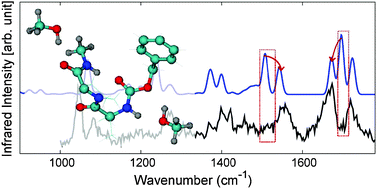Conformations and vibrational spectra of a model tripeptide: change of secondary structure upon micro-solvation†
Abstract
Mid-infrared (

- This article is part of the themed collection: Biomolecular Structures
* Corresponding authors
a
Institut für Mathematik, Freie Universität Berlin, Arnimallee 6, D-14195 Berlin, Germany
E-mail:
hui.zhu@fu-berlin.de, burkhard.schmidt@fu-berlin.de
b FOM Institute for Plasma Physics Rijnhuizen, Edisonbaan 14, NL-3439 Nieuwegein, The Netherlands
c Center for Theoretical Physics and Zernike Institute for Advanced Materials, University of Groningen, Nijenborgh 4, Groningen NL-9747 AG, The Netherlands
d
Fritz Haber Institut der Max-Planck-Gesellschaft, Faradayweg 4-6, D-14195 Berlin, Germany
E-mail:
helden@fhi-berlin.mpg.de
Mid-infrared (

 Please wait while we load your content...
Something went wrong. Try again?
Please wait while we load your content...
Something went wrong. Try again?
H. Zhu, M. Blom, I. Compagnon, A. M. Rijs, S. Roy, G. von Helden and B. Schmidt, Phys. Chem. Chem. Phys., 2010, 12, 3415 DOI: 10.1039/B926413B
To request permission to reproduce material from this article, please go to the Copyright Clearance Center request page.
If you are an author contributing to an RSC publication, you do not need to request permission provided correct acknowledgement is given.
If you are the author of this article, you do not need to request permission to reproduce figures and diagrams provided correct acknowledgement is given. If you want to reproduce the whole article in a third-party publication (excluding your thesis/dissertation for which permission is not required) please go to the Copyright Clearance Center request page.
Read more about how to correctly acknowledge RSC content.
 Fetching data from CrossRef.
Fetching data from CrossRef.
This may take some time to load.
Loading related content
